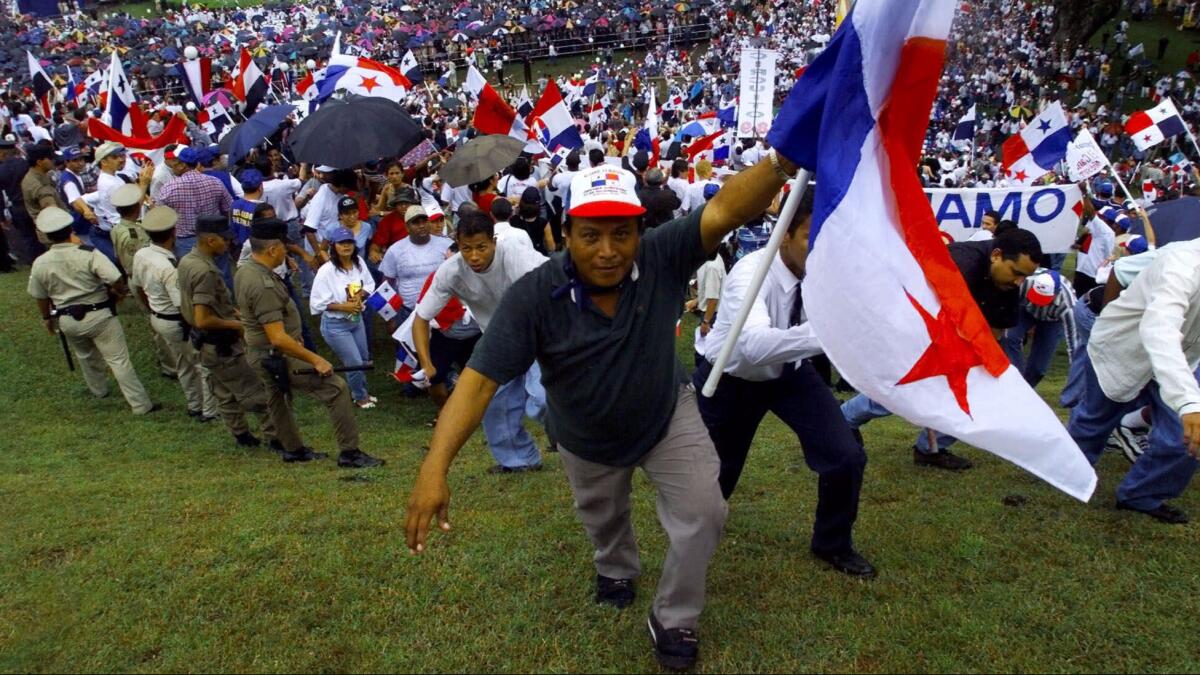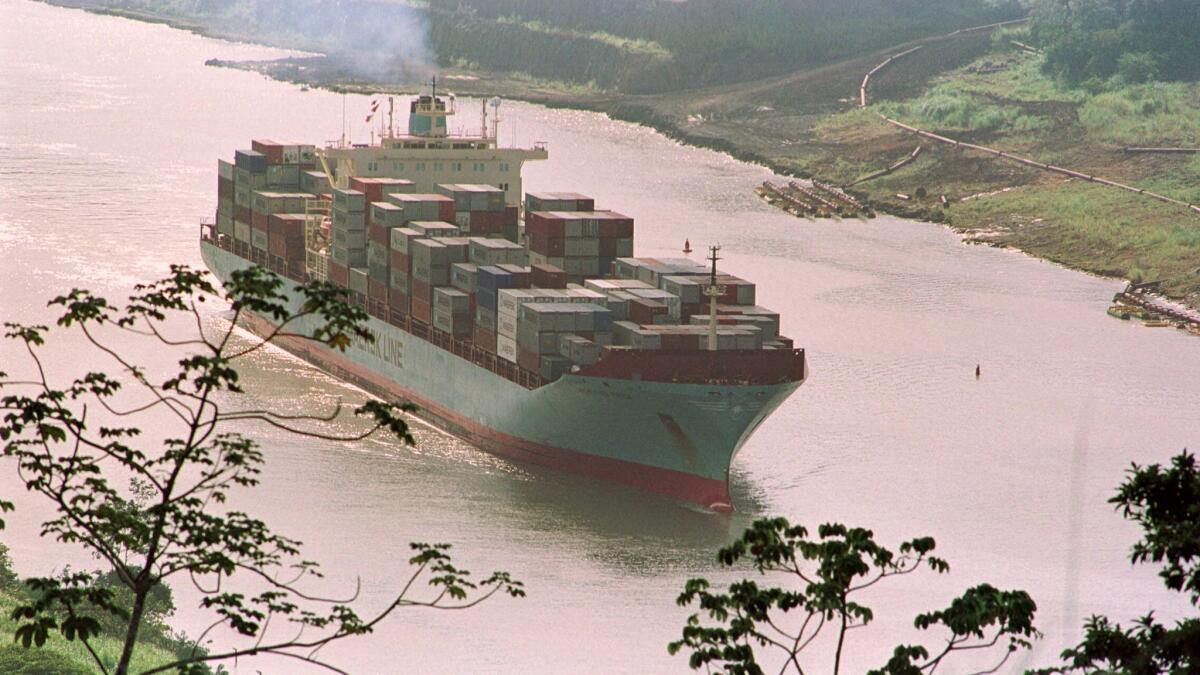From the archives:: Panama Canal handover ends decades of U.S. presence that began with break from Colombia

- Share via
Reporting from Panama City — The United States turned over control Friday of the Panama Canal to this Central American nation, withdrawing from a relationship that symbolized the best and the worst of the U.S. role in Latin America during the 20th century.
“The canal is ours,” Panamanian President Mireya Moscoso exclaimed, minutes before hoisting her nation’s flag over the canal administration building.
As the banner rose, thousands of balloons were released and scores of Panamanians, many waving flags, jubilantly broke through security cordons and charged up the hill toward the building, ignoring a tropical downpour.
As head of the U.S. delegation to the ceremony, Army Secretary Louis Caldera, chairman of the joint U.S.-Panamanian commission that had overseen the waterway’s administration, said the U.S. presence here had come to conflict with American principles.
“The United States could not aspire to be a good neighbor to Latin America and continue occupying and dividing the territory of a country considered a friend,” he said.
Moscoso and Caldera spoke at a noon ceremony ending nearly a century of U.S. domination that began when Washington engineered Panama’s separation from Colombia, leaving this country independent but not wholly sovereign.

While other Latin American nations have complained of the more than a dozen U.S. invasions in the region, the American presence in Panama had been continuous and decisive. As many as 30,000 U.S. soldiers and well-paid civilians have at times lived in the former Canal Zone, creating a dependency that even the most sovereign-minded Panamanians compare with a prolonged adolescence.
Vanquishing malaria and mudslides, the United States built, ran and protected the 51-mile-long waterway that opened in 1914. The canal united the Caribbean Sea and the Pacific Ocean but cut in half this nation of 2.5 million people. For most of this century, Panamanians could not enter a 10-mile-wide enclave of U.S. military bases and canal workers’ housing in the middle of their country.
It has been a uniquely American form of colonialism: It was never called that by name, but it left influences that have determined the demographics, economy and social structure of Panama.
As it ended, U.S. officials seemed eager to finish the chapter as quickly and quietly as possible. In the 22 years since President Carter negotiated a treaty with populist leader Gen. Omar Torrijos to gradually relinquish control of the canal to Panama, U.S. conservatives have protested the give-away as a sign of weakness.
The withdrawal has remained so controversial that no Cabinet-level U.S. official attended Friday’s ceremony or a special symbolic international gathering two weeks ago. The U.S. flag was removed from the canal administration offices for the last time at sunset Thursday to avoid the spectacle of lowering the Stars and Stripes on Friday when the Panamanian flag was raised.
There are more sophisticated ways to maintain a presence in Panama than continuing to support military bases and administer the canal.
— Ruben Blades, former Panamanian presidential candidate
Contrasting the U.S. attitude with the actions of the Portuguese exiting Macao on Dec. 20 and the British taking leave of Hong Kong more than two years ago, Panamanian political activist Ricardo Arias Calderon said, “England and Portugal made a conscious decision to have empires, and when they stopped being empires, they did it consciously. The U.S. became an empire despite itself.”
Although he has opposed the U.S. presence in Panama for decades, Arias said that without the canal his country would never have been economically viable.
U.S. Ambassador to Panama Simon Ferro denied that the U.S. withdrawal reflected any embarrassment.
“We did not leave in any way feeling that we had not had a positive impact on the history of Panama and the lives of Panamanians,” he said in a recent interview.
Nevertheless, he clearly preferred discussing the future of U.S.-Panamanian relations. “Trade, commerce and investment take on a bigger profile now that we have eliminated the all-consuming issue of the canal,” he said.
That would make Panama more like other Latin American countries, clamoring for admission to the free trade zone that U.S. leaders have promised to expand throughout the region.
“There are more sophisticated ways to maintain a presence in Panama than continuing to support military bases and administer the canal,” said salsa singer and former Panamanian presidential candidate Ruben Blades, who gave a free concert Friday to celebrate the hand-over. “I don’t think the United States would surrender [the canal] if it thought there was no other means to protect its interests.”
Indeed, Ferro said the U.S. will continue to provide support to preserve the jungles that supply the water critical to the canal’s system of locks and to cooperate with the 750-man Panamanian coast guard that patrols the waterway and its entrances.
Nevertheless, a helicopter ride over the 550 square miles of Panama that were once controlled by the United States shows that the U.S. presence is being diluted. A Spanish hotel chain is converting the School of the Americas, where the U.S. once trained Latin American soldiers, into a resort. The South Koreans and Taiwanese have turned two former military bases into industrial parks, and a Swiss lumber company has launched a reforestation project.
Hong Kong and Taiwanese corporations both manage ports in competition with a Seattle-based company. The role of the Hong Kong-based Hutchison Whampoa Ltd. in particular has upset U.S. conservatives who maintain that its presence gives China’s military a potential toehold in the Western Hemisphere.
NEWSLETTER: Get the day’s top headlines from Times Editor Davan Maharaj »
Still, Americans have provided the biggest chunk of the $1.5 billion in investments lined up over the last four years by the Interoceanic Region Authority, the government agency responsible for administering the former canal zone, said former Panamanian President Nicolas Ardito Barletta, who until Thursday was the administrator.
That balance could change. The authority is still looking for investors for 60% of the 62,000 acres scheduled for development. The rest is underwater or set aside for reserves to assure the canal’s water supply.
But a big influx of non-American investors is not likely, say those on the front lines of Asian and European investment.
“Business people from my country do not know much about Latin America,” said Marcos Chang, spokesman for the Taiwanese Embassy in Panama. “It has been difficult to convince them to invest.”
Panama’s ambassador to Germany, Enrique Thayer, has found that attracting European investment is even more difficult. “The general opinion is that the U.S. sort of takes care of Panama and that Europeans don’t have access,” he said.
That perception will change only gradually, he predicted. After all, Arias pointed out, the dollar will still be Panama’s de facto currency, English will remain the preferred second language and Panamanians will continue to cherish travel to the U.S.
“The United States will still be first among equals,” he said. “But at least now, there will be equals.”
More to Read
Sign up for Essential California
The most important California stories and recommendations in your inbox every morning.
You may occasionally receive promotional content from the Los Angeles Times.










